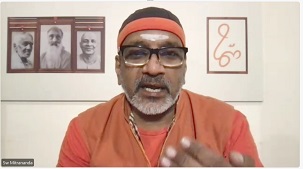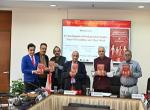Vivekananda International Foundation (VIF) organised the eighth session of ‘Gītā for the Millennia’, an online talk series based on Śrīmad Bhagavad Gītā by Swāmī Mitrananda of Chinmaya Mission on September 21, 2022.
At the beginning of his lecture, Swāmiji recollected that the second chapter of the Gītā covers almost all the topics of the entire text. From the third chapter onwards, each of these topics is discussed in greater detail. Likewise, the fourth chapter of the Gītā is titled Jñāna-Karma Sannyāsa Yoga. In this chapter, the Gītā discusses how to practice detachment through knowledge combined with action.
In the first verse of this chapter, Kṛṣṇa says that this knowledge was revealed from times immemorial and was passed from one generation to the other through memory (imaṁ vivasvate yogaṁ proktavān aham avyayam vivasvān manave prāha manur ikṣhvākave ’bravīt). Sometimes in these periods, this knowledge would have been lost, and then again, a master arrives and puts things back into practice. Kṛṣṇa says in this chapter that he will reveal that secret to Arjuna because Arjuna has friendliness and the required reverence towards Kṛṣṇa (Gītā 4.3). Swāmiji highlighted that a personal relationship between the student and the teacher is required to make knowledge impactful, which is built on love and reverence.
Whenever righteousness declines and adharma rises, God takes an avatāra to bring things back into balance. While explaining the verse, Swāmiji mentioned that God takes avatāra when an outside force forcefully disrupts balance, and not when an imbalance appears because of our weakness. At present, the decline of Dharma is not to that level when an avatāra has to manifest; rather, the case is that we have given ourselves to adharma. From time to time in our country, when some weakness happens, a great person has arisen to reset the whole thing. They are the glory of the lord, like Śaṅkarācārya or Vivekānanda. In our country there has always been at least a section of people who constantly seek the divine always. No matter how hard the onslaught is their long term vision to protect the knowledge stood firm. As a result of these collective efforts, we have many great masters who do timely interventions to support Dharma.
Another important verse which was mentioned in the lecture was Gītā 4.10 vīta-rāga-bhaya-krodhā man-mayā mām upāśhritāḥ bahavo jñāna-tapasā pūtā mad-bhāvam āgatāḥ. It means that to burn our ignorance, so as to receive knowledge, one should be free from three things:
- Rāga (attachment)
- Bhaya (fear)
- krodhā (anger)
Swāmiji clarified some of the persisting confusions surrounding these three terms. For instance, discarding anger doesn't mean discarding the demonstration of anger.
The session also discussed the verse that explains Varṇa, which often comes up in the debate of ‘caste’. The verse 4.13 states that chātur-varṇyaṁ mayā sṛiṣhṭaṁ guṇa-karma-vibhāgaśhaḥ tasya kartāram api māṁ viddhyakartāram avyayam. It means that Kṛṣṇa tells Arjuna that he created the four categories according to people’s qualities and activities. Here, the term ‘qualities’ means guṇa or modes, which are of three types – sattva guṇa (mode of goodness), rajo guṇa (mode of passion) and tamo guṇa (mode of ignorance). Based on these guṇa and karma, there are four varnas to which people belong.







Post new comment